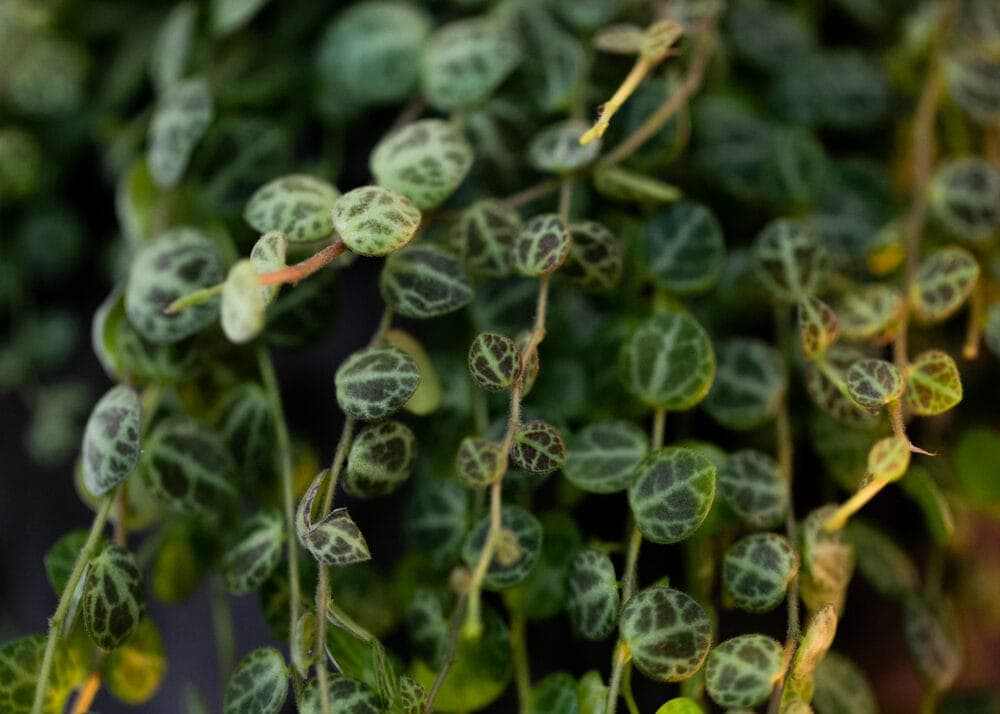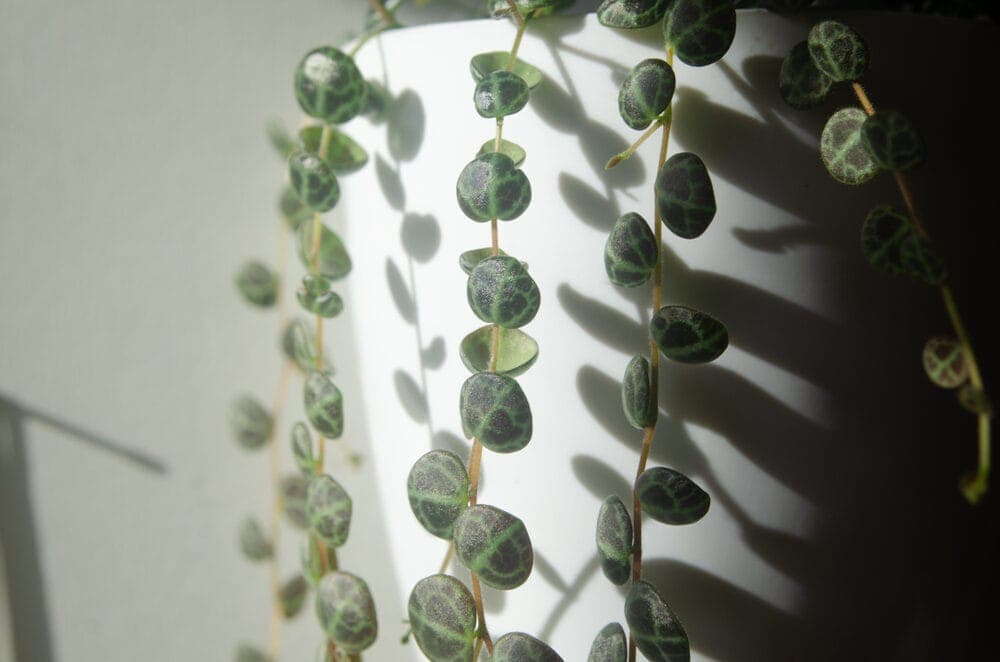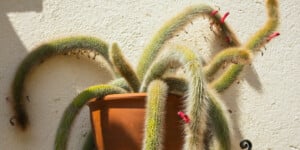If you’re looking for a plant that’s both distinct and low-maintenance, the string of turtles might be the one for you. This cute succulent gets its name from its oval-shaped leaves that resemble turtle shells.
Native to Brazilian rainforests, the string of turtles is part of the Piperaceae family and can grow up to 12 inches long. Keep reading for everything you need to know about caring for and growing this stylish succulent.
What is a String of Turtles plant?
The String of Turtles plant (Peperomia prostrata) is an unusual looking succulent that is native to the Brazilian rainforests. The String of Turtles plant gets its name from the way its leaves grow in a long, string-like formation.
It is part of the succulent family, as you can see by its fat little leaves. Besides water and sunlight, this plant doesn’t need much maintenance. It’s good to have for people who are busy and can’t water their plants every day.
String of Turtles Care & Growing Guide
1. Light requirements
Bright indirect light is the best light for the string of turtles. Don’t place this plant in full direct sunlight for many hours. One or two hours at most during the morning is good but not every day. Just keep it in a bright area of the house. It’s fun also grows very well under artificial or fluorescent lights.
2. Water
Over-watering this plant is very common, and each of its watering sessions should be spaced out. The topsoil should dry out before it is watered again. When the weather becomes warmer, you may want to spray the leaves with some water as well. If you can, add a little bit of liquid fertilizer to its water occasionally.
3. Climate and temperatures
The string of turtles loves to be in a humid climate and doesn’t like dry air or the cold ideally; this plant does best in 65 to 75F. If the temperature dips under 50 degrees, the plant will start to wilt.
4. Soil
Rich, well-fertilized soil is best for this plant because it will promote root growth and Vine robustness. The soil must drain away excess water quickly. If you need more aerated soil, you can add some perlite to the soil that you’re using now.
In the spring, you may want to add extra topsoil to replace the soil you lost throughout the year.

5. Repotting
The string of turtles plant is a small plant, and it doesn’t grow very fast, so repotting this plant doesn’t happen often. Only repot it if it’s becoming crowded. Choose a container or pot that is one to two inches bigger than its first one. The soil has to drain well to be then waterlogged roots.
6. Height and spread
The plant itself is not very tall. Most of the growth is dedicated to the vines. The height of the middle of the plants can go up to 4 in, and its width is also 4 inches. The vines, however, can grow to about a foot to a foot and a half in length. If the vines are cared for but not trimmed, they can keep growing even longer.
Similar post: Kangaroo Paw Fern Care & Growing Guide
7. Trimming
If the vines are getting too long, you can cut about a third of the vine off of the main plant. Check periodically to cut off dead or disease vines or foliage. Don’t trim the vine too much all at once, or you will shock the plant. The shock can also damage new growth and stop the whole plant from growing.
8. How to propagate the String of Turtles?
If you want to propagate listing of turtles plant, you can do this by cutting a three to four inches piece of vine off of the main plant. After the vine is cut, stick the end that is open into the pot and bury the vine an inch into the soil.
Do not take the leaves off of the vine. The potting soil should promote root growth. Don’t water until a week has passed but keep it in bright but indirect sunlight.

Does the String of Turtles have flowers, and how do I help them bloom?
Yes, unlike other peperomias, the string of turtles plant has small white flowers that bloom from it at different times throughout the year.
They look like small white spikes, so many people don’t like the way they look and remove them. These flowers don’t have a fragrance. There’s not much to do to help the flowers bloom. Just keep it well watered and keep it out of direct sunlight.
Is the String of Turtles poisonous?
No, the string of turtles plant is not toxic or poisonous to humans or pets. It is not meant for consumption in pet or human food either.
Can the String of Turtles grow in water?
No, the string of turtles plants cannot grow in water. It must fight off a couple of diseases that stem from being over-watered, and its roots cannot anchor this plant into the soil if it is soaked.
Also read: How to Choose the Best Soil & Fertilizer for Indoor Plants
Common String of Turtles Diseases and pests
Root rot is one of the biggest diseases this plant can face. If left unchecked, it will stunt a plant’s growth, turn it yellow, and kill the vines. Rot can also poison the soil and work its way into the roots and stem of your plant. To stop the rot from spreading, you need to dry out the soil around the string of turtles completely. If the plant is in a pot, transfer the plant to another pot with brand new soil but don’t water it for two weeks.
Red foliage is what happens to the leaves and vines when the string of turtles is exposed to too much direct sunlight. They can receive direct sunlight, but not a lot, and the sun can’t be intense. When this happens, limit the amount of sun the plant can receive to only one hour a day. You also have to remove all of the leaves that were damaged, and it turned red or yellow.
Leaf Drop occurs for several different reasons. The first reason is that there could be too much fertilizer in the soil or the water. String of turtles do well in regular potting soil and don’t like extra nutrients. The second reason is that the roots of the plant are waterlogged, and nutrients are being washed away from the roots. These problems are easy fixes. Just stop using fertilizer in the water for a while and allow the soil to try out more than you usually would before you water it again.
Learn more:
- Moses in the Cradle Plant Care & Growing Guide
- Arrowhead Plant Care & Growing Guide
- Mexican Palm Growth and Care Guide
Conclusion
- Trim the vines slowly, or you could cause shock and hurt the plant.
- This plant won’t poison humans and pets.
- Don’t let the climate your home drop below 50F.
- The soil should be moist.
- Although the king of turtles does have flowers, no one seems to care about them, and sometimes people trim them off the vine.
Victoria is the owner and main author of hobby plants. She loves spending her free time in her garden planting and taking care of her plants. Victoria hopes you enjoy the content here!
![How To Propagate A String Of Hearts? [BEGINNER'S GUIDE] How To Propagate A String Of Hearts? [BEGINNER'S GUIDE]](https://www.hobbyplants.com/wp-content/uploads/2022/07/how-to-propagate-string-of-hearts-300x158.jpg)




![Mother Of Thousands Plant [Complete Plant Care Guide] Mother Of Thousands Plant [Complete Plant Care Guide]](https://www.hobbyplants.com/wp-content/uploads/2022/07/mother-of-thousands-plant-300x158.jpg)
![Majesty Palm Plant Care: [Complete Beginner's Guide] Majesty Palm Plant Care: [Complete Beginner's Guide]](https://www.hobbyplants.com/wp-content/uploads/2022/08/majesty-palm-care-300x158.jpg)
![Exotic Angel Plant Care: [Complete Beginner's Guide] Exotic Angel Plant Care: [Complete Beginner's Guide]](https://www.hobbyplants.com/wp-content/uploads/2022/08/exotic-angel-plant-care-300x158.jpg)
![Snow White Waffle Plant: [Complete Care Guide] Snow White Waffle Plant: [Complete Care Guide]](https://www.hobbyplants.com/wp-content/uploads/2022/08/snow-white-waffle-plant-300x158.jpg)
![Waffle Plant Care: [Complete Beginner's Guide] Waffle Plant Care: [Complete Beginner's Guide]](https://www.hobbyplants.com/wp-content/uploads/2022/08/waffle-plant-300x158.jpg)
![Bird Of Paradise Plant Care: [Complete Beginner's Guide] Bird Of Paradise Plant Care: [Complete Beginner's Guide]](https://www.hobbyplants.com/wp-content/uploads/2022/08/bird-of-paradise-plant-300x158.jpg)
![Purple Passion Plant Care: [Complete Beginner's Guide] Purple Passion Plant Care: [Complete Beginner's Guide]](https://www.hobbyplants.com/wp-content/uploads/2022/08/purple-passion-plant-care-300x158.jpg)